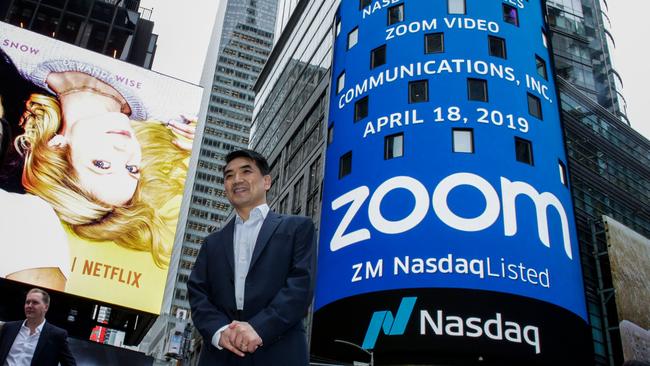Zoom and Biden White House demand staff return to the office
Zoom has asked staff to come into the office for at least two days a week, as White House chief of staff tells Biden’s cabinet to crack down on WFH.

Even Zoom, the company behind the iconic videoconferencing software, has had enough of ‘work from home’, as the Biden administration blasts the US public service for dragging the chain in bringing staff back to the office more than three years after the Covid-19 pandemic emerged.
The chief executive of the San Jose-based tech company, whose share prices exploded more than seven-fold during 2020 as hundreds of millions of workers sought out its videoconferencing application, told staff living within 50 miles (80km) of a Zoom office they would need to come to work at least two days a week from September.
“We believe that a structured hybrid approach — meaning employees that live near an office need to be on site two days a week to interact with their teams — is most effective for Zoom,” a Zoom company spokesman told Business Insider last week.
“We’ll continue to leverage the entire Zoom platform to keep our employees and dispersed teams connected and working efficiently”.
Zoom’s push for a two-day in-office requirement came as Joe Biden’s chief of staff Jeff Zients issued instructions on Friday (Saturday AEST) for federal government employees to return to their offices amid reports at least 75 per cent of federal office space remained empty.
“We are returning to in-person work because it is critical to the wellbeing of our teams and will enable us to deliver better results for the American people,” Mr Zients said in leaked email to Joe Biden’s cabinet ministers.
“This is a priority of the President — and I am looking to each of you to aggressively execute this shift in September and October,” it read.
The president’s March 2022 state of the union pledge to have “the vast majority of federal workers working again in person” appears to have stalled.
Seventeen of the 24 federal government agencies used an estimated 25 per cent of their headquarters buildings’ capacity throughout January, February, and March of 2023, according to a recent report of the US Government Accountability Office, suggesting a large share of the government’s 282,000 staff in the Washington catchment area were still working remotely.
“Federal agencies spend about US$2 billion a year to operate and maintain federal office buildings regardless of the buildings’ utilisation. In addition, agencies spend about US$5 billion annually to lease office buildings,” the agency said.
Former New York City mayor Michael Bloomberg slammed Washington bureaucrats last week in the Washington Post, writing the city was a “shadow of its former self, as too many federal employees continue working from home.”
“This has gone on too long. The pandemic is over. Excuses for allowing offices to sit empty should end, too”.
According to WFH Research, a collaboration of Stanford University economists, in July 2023, 12 per cent of full time American employees were fully remote, 59 per cent were at work five days a week, while 29 per cent had a hybrid arrangement.
Thirty per cent of paid full time work days were at home, compared to 5 per cent before the pandemic, it found.

Economics Professor Nicholas Bloom, who has analysed US WFH trends since 2020, said it was “very reasonable” for the federal government to demand a return to work given the fixed high cost of renting and maintaining office space, even though some evidence showed WFH improved productivity.
“The appeal of fully-remote – no office costs and hiring talent on lower international rates – is not there [for the government],” he told The Australian, while cautioning against arguments to bail out “big office blocks and real-estate companies”.
“City centres are empty but folks are in the suburbs, so total spending is flat”.
Elsewhere in the country, Wall Street banks have struggled to coax highly paid workers back into Manhattan offices, where employee attendance in the first five months of 2023, the official end of the Covid-19 pandemic, was 68 per cent of 2019 levels according to New York Post reporting.
“The evidence is that hybrid is helpful for mentoring, productivity and building culture, [especially] for Government work where it is hard to measure output [and] managing employees remotely is particularly challenging,” professor Bloom said.








To join the conversation, please log in. Don't have an account? Register
Join the conversation, you are commenting as Logout